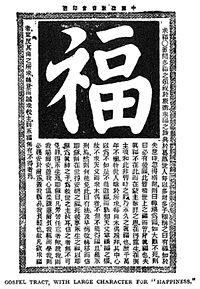Tract (literature)

A tract, is a literary work, and in current usage, usually religious in nature. The notion of what constitutes a tract has changed over time. By the early part of the twenty-first century, these meant small pamphlets used for religious and political purposes, though far more often the former. They are often either left for someone to find or handed out. However, there have been times in history when the term implied tome-like works.
Contents |
History
The distribution of tracts pre-dates the development of the printing press, with the term being applied by scholars to religious and political works at least as early as the 13th century. They were used to disseminated the teachings of John Wycliffe in the 14th century. As a political tool, they proliferated throughout Europe during the 17th century. They were printed as persuasive religious material from the time of Gutenberg's invention.
Religious tracts

As religious literature, they were used throughout the turbulence of the Protestant Reformation, and various uphevals of the 17th century. They came to such prominence again in the Oxford Movement that it became known as Tractarianism, after the publication in the 1830s and 1840s of a series of religious essays collectively called Tracts for the Times.
These tracts were written by a group of Church of England clergy including John Henry Newman, John Keble, Henry Edward Manning, and Edward Pusey. They were theological discourses that sought to establish the continuity between the Church of England and the patristic period of church history. They had a vast influence on Anglo-Catholicism. They were learned works and varied in length from four to over 400 pages.[1] An important center for the spreading of tracts was the London-based Religious Tract Society.[2] Tracts were used both within England - affecting the conversion of pioneer missionary to China, Hudson Taylor - as well as in the cross cultural missions movements such as Taylor founded: the China Inland Mission. Charles Spurgeon wrote many tracts, and in addition to these evangelical writings, his "Penny Sermons" were printed weekly and distributed widely by the millions and used in a similar way.
The publishing of tracts for religious purposes has continued unabated. In the United States, the American Tract Society has continuously published literature of this type since 1825. As evangelistic tools, tracts became promininent in the Jesus movement. One of the most widely distributed was "The Four Spiritual Laws" authored by Bill Bright of Campus Crusade for Christ and first published in 1965. "This Was Your Life" was the first of many tracts written by Jack Chick. Later Chick tracts followed the pattern vivid cartoon images and began to focus on issues of Fundamentalist Christianity, including vehement Anti-Catholic opinions.
In the 1980s and 1990s Last Days Ministries reprinted articles in the Last Days Newsletter by Keith Green and other contemporary and historic writers including David Wilkerson, Leonard Ravenhill, Winkie Pratney, Charles Finney, John Wesley, and William Booth. More recently Living Waters Publications prints tracts such as "The Atheist Test" or "Are You Good Enough to Go to Heaven?", as well as tracts which feature attention-getting illusions or gags. These include the "Million Dollar Bill", which caused a legal controversy in June 2006.
Political tracts
Brochure-like tracts, also known as pamphlets, advocating political positions have also been used throughout history as well. They were used throughout Europe in the 17th century. In the 18th century, they featured prominently in the political unrest leading up to the American Revolution. A well-known example of a far-reaching tracts from this era is Common Sense by Thomas Paine.
Tracts were used for political purposes throughout the 20th century. They were used to spread Nazi propaganda in central Europe during the 1930s and 1940s. According to Jack Chick, his impetus to design cartoon-based religious tracts was brought on by hearing of a similar promotional tool used by Communists in China to wide success. [3] In the months before the John F. Kennedy assassination, Lee Harvey Oswald handed out pamphlets promoting Fidel Castro and Communist Cuba on the streets of New Orleans, Louisiana.
See also

- Nezikin
- Minor Tractates
- Pamphlet